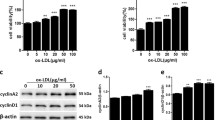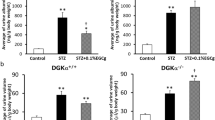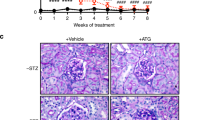Abstract
Epigallocatechin-3-gallate (EGCG), a bioactive component of green tea, has been reported to exert anti-inflammatory effects on immune cells. EGCG is also shown to activate the metabolic regulator, adenosine 5'-monophosphate-activated protein kinase (AMPK). Reports have also indicated that EGCG inhibits the immune-stimulated phosphoinositide 3-kinase (PI3K)/Akt/mammalian target of rapamycin (mTOR) pathway. The PI3K/Akt/mTOR pathway has been implicated in mesangial cell activation in lupus. Mesangial cells from MRL/lpr lupus-like mice are hyper-responsive to immune stimulation and overproduce nitric oxide (NO) and other inflammatory mediators when stimulated. In our current studies, we sought to determine the mechanism by which EGCG attenuates immune-induced expression of pro-inflammatory mediators. Cultured mesangial cells from MRL/lpr mice were pre-treated with various concentrations of EGCG and stimulated with lipopolysaccharide (LPS)/interferon (IFN)-γ. EGCG activated AMPK and blocked LPS/IFN-γ-induced inflammatory mediator production (iNOS expression, supernatant NO and interleukin-6). Interestingly, EGCG attenuated inflammation during AMPK inhibition indicating that the anti-inflammatory effect of EGCG may be partially independent of AMPK activation. Furthermore, we found that EGCG effectively inhibited the immune-stimulated PI3K/Akt/mTOR pathway independently of AMPK, by decreasing phosphorylation of Akt, suggesting an alternate mechanism for EGCG-mediated anti-inflammatory action in mesangial cells. Taken together, these studies show that EGCG attenuated inflammation in MRL/lpr mouse mesangial cells via the PI3K/Akt/mTOR pathway. Our findings suggest a potential therapeutic role for the use of EGCG to regulate inflammation and control autoimmune disease.
This is a preview of subscription content, access via your institution
Access options
Subscribe to this journal
Receive 12 digital issues and online access to articles
$119.00 per year
only $9.92 per issue
Buy this article
- Purchase on Springer Link
- Instant access to full article PDF
Prices may be subject to local taxes which are calculated during checkout








Similar content being viewed by others
References
Fessel WJ . Epidemiology of systemic lupus erythematosus. Rheum Dis Clin North Am 1988; 14: 15–23.
Le Marchand L . Cancer preventive effects of flavonoids – a review. Biomed Pharmacother 2002; 56: 296–301.
Farabegoli F, Barbi C, Lambertini E, Piva R . (−)-Epigallocatechin-3-gallate downregulates estrogen receptor alpha function in MCF-7 breast carcinoma cells. Cancer Detect Prev 2007; 31: 499–504.
Shankar S, Ganapathy S, Hingorani SR, Srivastava RK . EGCG inhibits growth, invasion, angiogenesis and metastasis of pancreatic cancer. Front Biosci 2008; 13: 440–452.
Wolfram S, Raederstorff D, Preller M, Wang Y, Teixeira SR, Riegger C et al. Epigallocatechin gallate supplementation alleviates diabetes in rodents. J Nutr 2006; 136: 2512–2518.
Singh R, Ahmed S, Malemud CJ, Goldberg VM, Haqqi TM . Epigallocatechin-3-gallate selectively inhibits interleukin-1beta-induced activation of mitogen activated protein kinase subgroup c-Jun N-terminal kinase in human osteoarthritis chondrocytes. J Orthop Res 2003; 21: 102–109.
Ahmed S, Rahman A, Hasnain A, Lalonde M, Goldberg VM, Haqqi TM . Green tea polyphenol epigallocatechin-3-gallate inhibits the IL-1 beta-induced activity and expression of cyclooxygenase-2 and nitric oxide synthase-2 in human chondrocytes. Free Radic Biol Med 2002; 33: 1097–1105.
Singh R, Ahmed S, Islam N, Goldberg VM, Haqqi TM . Epigallocatechin-3-gallate inhibits interleukin-1beta-induced expression of nitric oxide synthase and production of nitric oxide in human chondrocytes: suppression of nuclear factor kappaB activation by degradation of the inhibitor of nuclear factor kappaB. Arthritis Rheum 2002; 46: 2079–2086.
Fu Y, Koo MW . EGCG protects HT-22 cells against glutamate-induced oxidative stress. Neurotox Res 2006; 10: 23–30.
Nishikawa H, Wakano K, Kitani S . Inhibition of NADPH oxidase subunits translocation by tea catechin EGCG in mast cell. Biochem Biophys Res Commun 2007; 362: 504–509.
Wolfram S, Wang Y, Thielecke F . Anti-obesity effects of green tea: from bedside to bench. Mol Nutr Food Res 2006; 50: 176–187.
Wu CH, Wu CF, Huang HW, Jao YC, Yen GC . Naturally occurring flavonoids attenuate high glucose-induced expression of proinflammatory cytokines in human monocytic THP-1 cells. Mol Nutr Food Res 2009; 53: 984–995.
Bae H-B, Li M, Kim J-P, Kim S-J, Jeong C-W, Lee H-G et al. The effect of epigallocatechin gallate on lipopolysaccharide-induced acute lung injury in a murine model. Inflammation 2009; in press.
Zhu J, Wang O, Ruan L, Hou X, Cui Y, Wang JM et al. The green tea polyphenol (−)-epigallocatechin-3-gallate inhibits leukocyte activation by bacterial formylpeptide through the receptor FPR. Int Immunopharmacol 2009; 9: 1126–1130.
Hwang JT, Ha J, Park IJ, Lee SK, Baik HW, Kim YM et al. Apoptotic effect of EGCG in HT-29 colon cancer cells via AMPK signal pathway. Cancer Lett 2007; 247: 115–121.
Jeong HW, Hsu KC, Lee JW, Ham M, Huh JY, Shin HJ et al. Berberine suppresses proinflammatory responses through AMPK activation in macrophages. Am J Physiol Endocrinol Metab 2009; 296: E955–E964.
Sag D, Carling D, Stout RD, Suttles J . Adenosine 5'-monophosphate-activated protein kinase promotes macrophage polarization to an anti-inflammatory functional phenotype. J Immunol 2008; 181: 8633–8641.
Theofilopoulos AN, Dixon FJ . Murine models of systemic lupus erythematosus. Adv Immunol 1985; 37: 269–390.
Theofilopoulos AN, Kono DH . Mechanisms and genetics of autoimmunity. Ann N Y Acad Sci 1998; 841: 225–235.
Cook HT, Smith J, Salmon JA, Cattell V . Functional characteristics of macrophages in glomerulonephritis in the rat. O2-generation, MHC class II expression, and eicosanoid synthesis. Am J Pathol 1989; 134: 431–437.
Reilly CM, Oates JC, Sudian J, Crosby MB, Halushka PV, Gilkeson GS . Prostaglandin J(2) inhibition of mesangial cell iNOS expression. Clin Immunol 2001; 98: 337–345.
Zhou Y, Ling E, Dheen S . Dexamethasone suppresses monocyte chemoattractant protein-1 production via mitogen activated protein kinase phosphatase-1 dependent inhibition of Jun N-terminal kinase and p38 mitogen-activated protein kinase in activated rat microglia. J Neurochem 2007; 102: 667–678.
Reilly CM, Farrelly LW, Viti D, Redmond ST, Hutchison F, Ruiz P et al. Modulation of renal disease in MRL/lpr mice by pharmacologic inhibition of inducible nitric oxide synthase. Kidney Int 2002; 61: 839–846.
Bollain-y-Goytia JJ, Ramirez-Sandoval R, Daza L, Esparza E, Barbosa O, Ramirez D et al. Widespread expression of inducible NOS and citrulline in lupus nephritis tissues. Inflamm Res 2009; 58: 61–66.
Oates JC, Shaftman SR, Self SE, Gilkeson GS . Association of serum nitrate and nitrite levels with longitudinal assessments of disease activity and damage in systemic lupus erythematosus and lupus nephritis. Arthritis Rheum 2008; 58: 263–272.
Kashem A, Endoh M, Yano N, Yamauchi F, Nomoto Y, Sakai H . Expression of inducible-NOS in human glomerulonephritis: the possible source is infiltrating monocytes/macrophages. Kidney Int 1996; 50: 392–399.
Reilly CM, Mishra N, Miller JM, Joshi D, Ruiz P, Richon VM et al. Modulation of renal disease in MRL/lpr mice by suberoylanilide hydroxamic acid. J Immunol 2004; 173: 4171–4178.
Gilkeson G, Cannon C, Oates J, Reilly C, Goldman D, Petri M . Correlation of serum measures of nitric oxide production with lupus disease activity. J Rheumatol 1999; 26: 318–324.
Vermes I, Haanen C, Steffens-Nakken H, Reutellingsperger. A novel assay for apoptosis Flow cytometric detection of phosphatidylserine expression on early apoptotic cells using fluorescein labelled Annexin V. J Immunol Methods 1995; 184: 39–51.
Peairs A, Radjavi A, Davis S, Li L, Ahmed A, Giri S et al. Activation of AMPK inhibits inflammation in MRL/lpr mouse mesangial cells. Clin Exp Immunol 2009; 156: 542–551.
Collins QF, Liu HY, Pi J, Liu Z, Quon MJ, Cao W . Epigallocatechin-3-gallate (EGCG), a green tea polyphenol, suppresses hepatic gluconeogenesis through 5'-AMP-activated protein kinase. J Biol Chem 2007; 282: 30143–30149.
Moon HS, Chung CS, Lee HG, Kim TG, Choi YJ, Cho CS . Inhibitory effect of (−)-epigallocatechin-3-gallate on lipid accumulation of 3T3-L1 cells. Obesity (Silver Spring) 2007; 15: 2571–2582.
Oh JH, Lee TJ, Park JW, Kwon TK . Withaferin A inhibits iNOS expression and nitric oxide production by Akt inactivation and down-regulating LPS-induced activity of NF-kappaB in RAW 264.7 cells. Eur J Pharmacol 2008; 599: 11–17.
Jung CH, Jung H, Shin YC, Park JH, Jun CY, Kim HM et al. Eleutherococcus senticosus extract attenuates LPS-induced iNOS expression through the inhibition of Akt and JNK pathways in murine macrophage. J Ethnopharmacol 2007; 113: 183–187.
Sheu ML, Chao KF, Sung YJ, Lin WW, Lin-Shiau SY, Liu SH . Activation of phosphoinositide 3-kinase in response to inflammation and nitric oxide leads to the up-regulation of cyclooxygenase-2 expression and subsequent cell proliferation in mesangial cells. Cell Signal 2005; 17: 975–984.
Lim HK, Choi YA, Park W, Lee T, Ryu SH, Kim SY et al. Phosphatidic acid regulates systemic inflammatory responses by modulating the Akt-mammalian target of rapamycin-p70S6 kinase 1 pathway. J Biol Chem 2003; 278: 45117–45127.
Cao W, Manicassamy S, Tang H, Kasturi SP, Pirani A, Murthy N et al. Toll-like receptor-mediated induction of type I interferon in plasmacytoid dendritic cells requires the rapamycin-sensitive PI(3)K-mTOR-p70S6K pathway. Nat Immunol 2008; 9: 1157–1164.
Park IJ, Lee YK, Hwang JT, Kwon DY, Ha J, Park OJ . Green tea catechin controls apoptosis in colon cancer cells by attenuation of H2O2-stimulated COX-2 expression via the AMPK signaling pathway at low-dose H2O2 . Ann NY Acad Sci 2009; 1171: 538–544.
Schulz E, Anter E, Zou MH, Keaney JF Jr . Estradiol-mediated endothelial nitric oxide synthase association with heat shock protein 90 requires adenosine monophosphate-dependent protein kinase. Circulation 2005; 111: 3473–3480.
Huang CH, Tsai SJ, Wang YJ, Pan MH, Kao JY, Way TD . EGCG inhibits protein synthesis, lipogenesis, and cell cycle progression through activation of AMPK in p53 positive and negative human hepatoma cells. Mol Nutr Food Res 2009; 53: 1156–1165.
Murase T, Misawa K, Haramizu S, Hase T . Catechin-induced activation of the LKB1/AMP-activated protein kinase pathway. Biochem Pharmacol 2009; 78: 78–84.
De Vera ME, Taylor BS, Wang Q, Shapiro RA, Billiar TR, Geller DA . Dexamethasone suppresses iNOS gene expression by upregulating I-kappa B alpha and inhibiting NF-kappa B. Am J Physiol 1997; 273: G1290–G1296.
Grassl C, Luckow B, Schlondorff D, Dendorfer U . Transcriptional regulation of the interleukin-6 gene in mesangial cells. J Am Soc Nephrol 1999; 10: 1466–1477.
Eberhardt W, Pluss C, Hummel R, Pfeilschifter J . Molecular mechanisms of inducible nitric oxide synthase gene expression by IL-1beta and cAMP in rat mesangial cells. J Immunol 1998; 160: 4961–4969.
Bacher S, Schmitz ML . The NF-κB pathway as a potential target for autoimmune disease therapy. Curr Pharm Des 2004; 10: 2827–2837.
Dale E, Davis M, Faustman DL . A role for transcription factor NF-kappaB in autoimmunity: possible interactions of genes, sex, and the immune response. Adv Physiol Educ 2006; 30: 152–158.
Kurylowicz AA . The role of nuclear factor-kappaB in the development of autoimmune diseases: a link between genes and environment. Acta biochim pol 2008; 55: 629–647.
Fu Y, Xie C, Yan M, Li Q, Joh JW, Lu C et al. The lipopolysaccharide-triggered mesangial transcriptome: evaluating the role of interferon regulatory factor-1. Kidney Int 2005; 67: 1350–1361.
Giri S, Nath N, Smith B, Viollet B, Singh AK, Singh I . 5-aminoimidazole-4-carboxamide-1-beta-4-ribofuranoside inhibits proinflammatory response in glial cells: a possible role of AMP-activated protein kinase. J Neurosci 2004; 24: 479–487.
Zhao X, Zmijewski JW, Lorne E, Liu G, Park YJ, Tsuruta Y et al. Activation of AMPK attenuates neutrophil proinflammatory activity and decreases the severity of acute lung injury. Am J Physiol Lung Cell Mol Physiol 2008; 295: L497–L504.
Barati MT, Rane MJ, Klein JB, McLeish KR . A proteomic screen identified stress-induced chaperone proteins as targets of Akt phosphorylation in mesangial cells. J Proteome Res 2006; 5: 1636–1646.
Nagai K, Matsubara T, Mima A, Sumi E, Kanamori H, Iehara N et al. Gas6 induces Akt/mTOR-mediated mesangial hypertrophy in diabetic nephropathy. Kidney Int 2005; 68: 552–561.
Fayard E, Tintignac LA, Baudry A, Hemmings BA . Protein kinase B/Akt at a glance. J Cell Sci 2005; 118: 5675–5678.
Yang J, Cron P, Good VM, Thompson V, Hemmings BA, Barford D . Crystal structure of an activated Akt/protein Kinase B ternary complex with GSK3-peptide and AMP-PNP. Nat Struct Mol Biol 2002; 9: 940–944.
Wu T, Mohan C . The AKT axis as a therapeutic target in autoimmune diseases. Endoc Metab Immune Disord Drug Targets 2009; 9: 145–150.
Zhang T, Yang D, Fan Y, Xie P, Li H . Epigallocatechin-3-gallate enhances ischemia/reperfusion-induced apoptosis in human umbilical vein endothelial cells via AKT and MAPK pathways. Apoptosis 2009; 14: 1245–1254.
Ahn HY, Xu Y, Davidge ST . Epigallocatechin-3-O-gallate inhibits TNFalpha-induced monocyte chemotactic protein-1 production from vascular endothelial cells. Life Sci 2008; 82: 964–968.
Ohga N, Hida K, Hida Y, Muraki C, Tsuchiya K, Matsuda K et al. Inhibitory effects of epigallocatechin-3 gallate, a polyphenol in green tea, on tumor-associated endothelial cells and endothelial progenitor cells. Cancer Sci 2009; 100: 1963–1970.
Navarro-Peran E, Cabezas-Herrera J, Sanchezp-del-Campo L, Garcia-Canovas F, Rodriguez-Lopez N . The anti-inflammatory and anti-cancer properties of epigallocatechin-3-gallate are mediated by folate cycle disruption, adenosine release and NF-κB suppression. Inflamm Res 2008; 57: 1–7.
Kim JM, Kim HI, Chung J, Jeong TS, Park HR . (−)-Epigallocatechin-3-gallate (EGCG) increases the viability of serum-starved A549 cells through its effect on Akt. Am J Chin Med 2009; 37: 723–734.
Lin SK, Chang HH, Chen YJ, Wang CC, Galson DL, Hong CY et al. Epigallocatechin-3-gallate diminishes CCL2 expression in human osteoblastic cells via up-regulation of phosphatidylinositol 3-kinase/Akt/Raf-1 interaction: a potential therapeutic benefit for arthritis. Arthritis Rheum 2008; 58: 3145–3156.
Weichhart T, Säemann MD . The PI3K/Akt/mTOR pathway in innate immune cells: emerging therapeutic applications. Ann Rheum Dis 2008; 67: iii70–iii74.
Xing B, Xin T, Hunter R, Bing G . Pioglitazone inhibition of lipopolysaccharide-induced nitric oxide synthase is associated with altered activity of p38 MAP kinase and PI3K/Akt. J Neuroinflammation 2008; 5: 4.
Di Cristofano A, Kotsi P, Peng YF, Cordon-Cardo C, Elkon KB, Pandolfi PP . Impaired Fas response and autoimmunity in Pten+/− mice. Science 1999; 285: 2122–2125.
R-Borlado L, Redondo C, Alvarez B, Jimenez C, Criado LM, Flores J et al. Increased phosphoinositide 3-kinase activity induces a lymphoproliferative disorder and contributes to tumor generation in vivo. FASEB J 2000; 14: 895–903.
Wei CC, Chang MS . A novel transcript of mouse interleukin-20 receptor acts on glomerular mesangial cells as an aggravating factor in lupus nephritis. Genes Immun 2008; 9: 668–679.
Barber DF, Bartolomé A, Hernandez C, Flores JM, Redondo C, Fernandez-Arias C et al. PI3K-gamma inhibition blocks glomerulonephritis and extends lifespan in a mouse model of systemic lupus. Nat Med 2005; 11: 933–935.
Wu T, Qin X, Kurepa Z, Kumar KR, Liu K, Kanta H et al. Shared signaling networks active in B cells isolated from genetically distinct mouse models of lupus. J Clin Invest 2007; 117: 2186–2196.
Marone R, Cmiljanovic V, Giese B, Wymann MP . Targeting phosphoinositide 3-kinase: moving towards therapy. Biochim Biophys Acta 2008; 1784: 159–185.
Lui S, Yung S, Tsang R, Zhang F, Chan K, Tam S et al. Rapamycin prevents the development of nephritis in lupus-prone NZB/W F1 mice. Lupus 2008; 17: 305–313.
Reddy P, Legault H, Sypek J, Collins M, Goad E, Goldman S et al. Mapping similarities in mTOR pathway perturbations in mouse lupus nephritis models and human lupus nephritis. Arthritis Res Ther 2008; 10: R127.
Ramos-Barron A, Pinera-Haces C, Gomez-Alamillo C, Santiuste-Torcida I, Ruiz J, Buelta-Carrillo L et al. Prevention of murine lupus disease in (NZBxNZW)F1 mice by sirolimus treatment. Lupus 2007; 16: 775–781.
Warner L, Adams L, Sehgal S . Rapamycin prolongs survival and arrests pathophysiologic changes in murine systemic lupus erythematosus. Arthritis Rheum 1994; 37: 289–297.
Hochegger K, Jansky GL, Soleiman A, Wolf AM, Tagwerker A, Seger C et al. Differential effects of rapamycin in anti-GBM glomerulonephritis. J Am Soc Nephrol 2008; 19: 1520–1529.
Vogelbacher R, Wittmann S, Braun A, Daniel C, Hugo C . The mTOR inhibitor everolimus induces proteinuria and renal deterioration in the remnant kidney model in the rat. Transplantation 2007; 84: 1492–1499.
Letavernier E, Bruneval P, Mandet C, Van Huyen JP, Peraldi MN, Helal I et al. High sirolimus levels may induce focal segmental glomerulosclerosis de novo. Clin J Am Soc Nephrol 2007; 2: 326–333.
Salcedo R, Ponce ML, Young HA, Wasserman K, Ward JM, Kleinman HK et al. Human endothelial cells express CCR2 and respond to MCP-1: direct role of MCP-1 in angiogenesis and tumor progression. Blood 2000; 96: 34–40.
Yoshida M, Xia Y . Heat Shock Protein 90 as an endogenous protein enhancer of inducible nitric-oxide synthase. J Biol Chem 2003; 278: 36953–36958.
Acknowledgements
This project was funded by grants from the Harvey Peters Foundation (Peairs), Arthritis Foundation (Reilly) and the NIH/NIAD grant 1R15A1072756 (Reilly). The authors would also like to acknowledge the laboratory assistance of Krystina Cocco, Sarah Muse, Nicole Regna and David Fulbrook, in addition to Melissa Makris for flow cytometry.
Author information
Authors and Affiliations
Corresponding author
Rights and permissions
About this article
Cite this article
Peairs, A., Dai, R., Gan, L. et al. Epigallocatechin-3-gallate (EGCG) attenuates inflammation in MRL/lpr mouse mesangial cells. Cell Mol Immunol 7, 123–132 (2010). https://doi.org/10.1038/cmi.2010.1
Received:
Revised:
Accepted:
Published:
Issue Date:
DOI: https://doi.org/10.1038/cmi.2010.1
Keywords
This article is cited by
-
Green tea EGCG effectively alleviates experimental colitis in middle-aged male mice by attenuating multiple aspects of oxi-inflammatory stress and cell cycle deregulation
Biogerontology (2022)
-
miR-1968-5p is involved in the pathogenesis of lupus nephritis of NZBWF1 mice by targeting csf1
Clinical and Experimental Nephrology (2021)
-
Effects of epigallocatechin-3-gallate on systemic inflammation-induced cognitive dysfunction in aged rats
Journal of Anesthesia (2017)
-
MicroRNA-let-7a promotes E2F-mediated cell proliferation and NFκB activation in vitro
Cellular & Molecular Immunology (2014)
-
Dietary phytochemicals alter epigenetic events and signaling pathways for inhibition of metastasis cascade
Cancer and Metastasis Reviews (2014)



